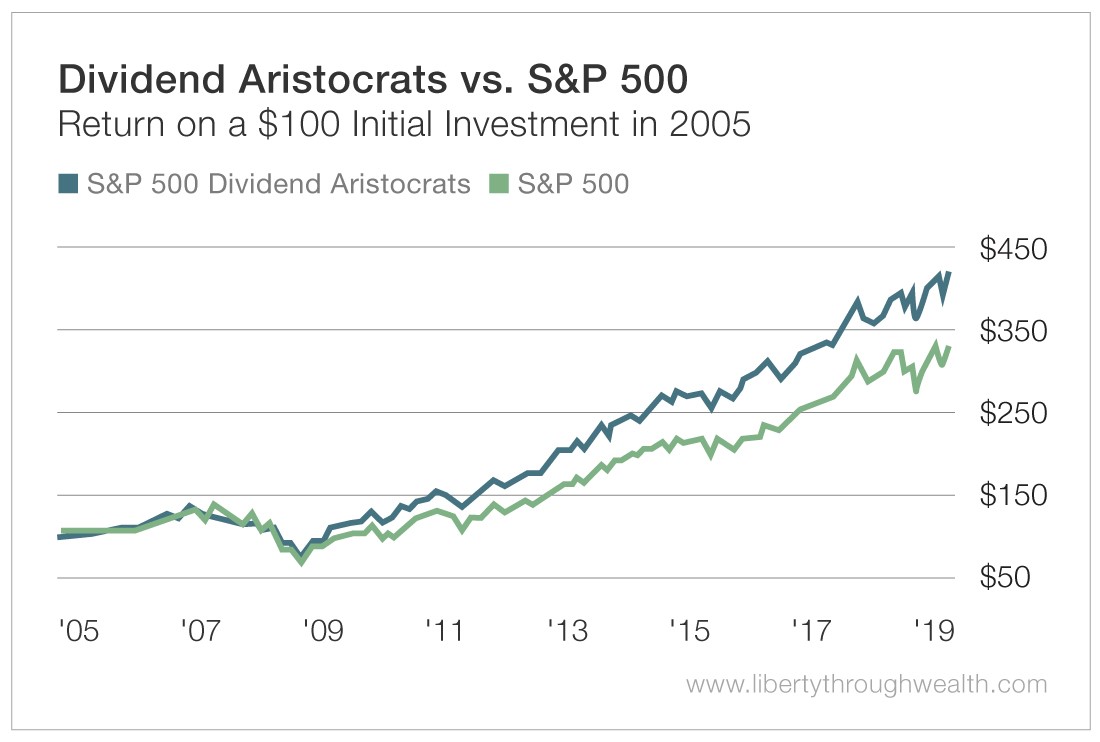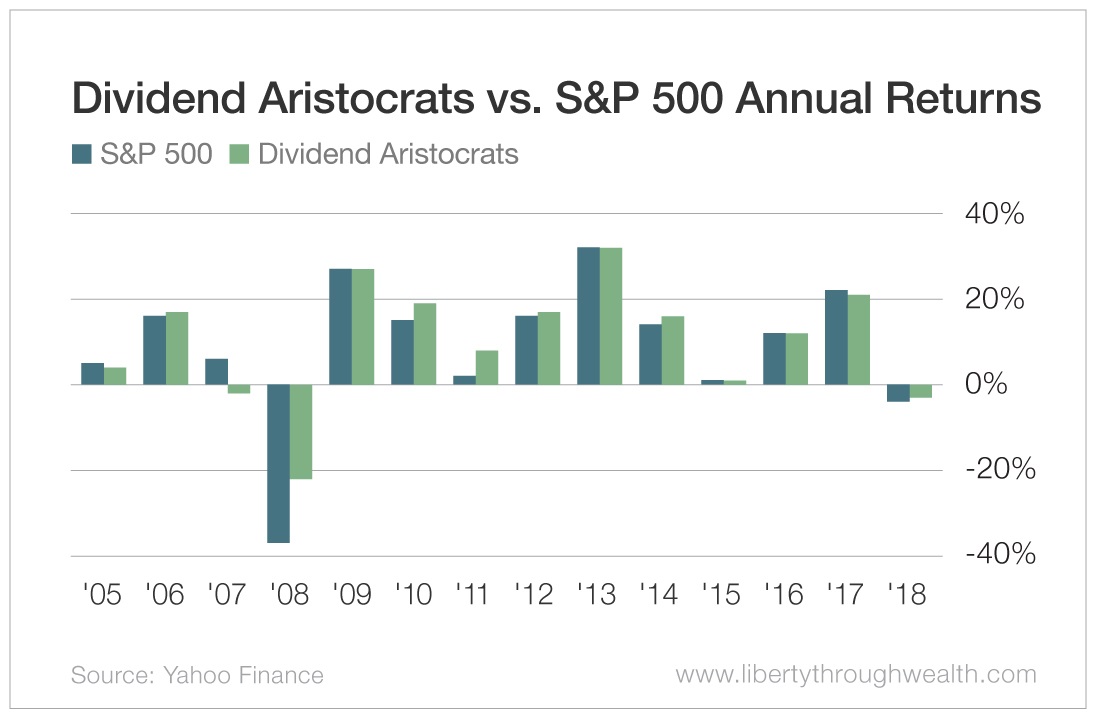Invest Royally and Survive Market Turbulence
- The S&P 500 has seen both record highs and continued volatility this year, shifting many investors toward less risky assets.
- Today, Nicholas Vardy explains a proven ETF trading strategy that shines during market turmoil and generates steady income.
The S&P 500 hit a record high in late July.
Yet few investors are partying like it’s 1999.
That’s because, for most investors, 2019 has been more about stomach-churning market volatility spurred by slowing global growth and the escalating trade war with China.
As the market continues its recent roller-coaster ride, I’m reminded of one of the most fundamental truths of investing: No single strategy works all of the time.
Some strategies thrive in bull markets. Others excel when the bear is growling at the door.
However, one strategy fares better than most during times of market turbulence: investing in high-dividend stocks.
The Market Elite
An elite group of dividend stocks has continuously performed royally – even in times of turmoil. So just who are the members of this select group?
They are called “Dividend Aristocrats.”
Dividend Aristocrats are S&P 500 companies that boast long track records of increasing their dividends year after year – regardless of Mr. Market’s mood swings.
(And yes, this track record includes the dot-com crash of 2000 and the global financial crisis of 2008.)
Dividend Aristocrats are high-quality companies led by shareholder-friendly management teams that enjoy durable competitive advantages. No wonder investing in them has beaten the S&P 500 over many years…

The S&P 500 Dividend Aristocrats Index has tracked the performance of the Dividend Aristocrats since 2005. Specifically, the index…
- Is composed of S&P 500 companies that have increased their total dividends per share amount every year for at least 25 consecutive years
- Includes a minimum of 40 stocks and weights them equally
- Limits the weight of any single sector to no more than 30% of the index
- Is rebalanced to equal weight quarterly in January, April, July and October.
Currently, just 57 companies – a little more than 11% of the S&P 500 – meet these stringent requirements.
Let’s see what these Dividend Aristocrats look like…
First, they are kind of “boring” companies that value investors love, such as 3M (NYSE: MMM), Stanley Black & Decker Inc. (NYSE: SWK) and Cincinnati Financial Corporation (Nasdaq: CINF).
Now, none of these companies will make your pulse race during a go-go bull market. These mature, slow-growing firms tend to trade at far lower valuations than the Netflixes and Amazons of the world.
They also pay out a larger share of their earnings as dividends compared with their faster-growing counterparts. That explains why – as a group – Dividend Aristocrats boast an average dividend yield of 2% compared with the S&P 500’s 1.8%.
But you need to look deeper to unearth what I believe is the Dividend Aristocrats’ most important edge…
And that is that periods of market mayhem are when the Dividend Aristocrats really shine.
Most notably, during the global financial crisis of 2008, the S&P 500 was down 37%. But the Dividend Aristocrats dropped only 22% the same year.

The Dividend Aristocrats were equally robust during the market sell-off late last year. While the S&P 500 fell about 10%, the Dividend Aristocrats dropped only 7%.
In short…
Dividend Aristocrats tend to capture almost all of the upside of the S&P 500, while suffering only about 70% of the market’s drawdowns.
And here’s the best news…
You don’t need to track and invest in each of the 57 Dividend Aristocrats to make money from them. Today, you can invest in the S&P 500 Dividend Aristocrats Index by simply buying the ProShares S&P 500 Dividend Aristocrats ETF (CBOE: NOBL).
A Portfolio of Income Strategies
As I’ve written before, exchange-traded funds (ETFs) are the most flexible instruments in today’s financial markets.
There are more than 2,000 ETFs currently trading on U.S. stock exchanges – allowing you to custom-build a portfolio that invests in virtually any strategy or asset class, and even profit from market slumps.
Investing in reliable blue chip stocks like Dividend Aristocrats is a great way to generate a steady income. But don’t overlook the multitude of other ways ETFs can do that.
Real estate investment trusts, municipal bonds, business development companies and U.S. dollar-denominated sovereign debt are just a handful of the diverse income-generating ETF strategies you can implement.
That’s why I’ve recently added an income ETF portfolio to my Oxford Wealth Accelerator trading service.
The benefits of using ETFs for generating income are clear: By investing in a portfolio of diverse strategies, you’re not relying on a single income source. You’ll also be generating a much higher income than the overall U.S. market. My current income ETF portfolio yields 6.6%, more than triple the S&P 500’s 1.8%.
If you are currently an Oxford Wealth Accelerator subscriber, be sure to check out the new Income Portfolio and keep an eye out for upcoming recommendations.
[adzerk-get-ad zone="245143" size="4"]About Nicholas Vardy
An accomplished investment advisor and widely recognized expert on quantitative investing, global investing and exchange-traded funds, Nicholas has been a regular commentator on CNN International and Fox Business Network. He has also been cited in The Wall Street Journal, Financial Times, Newsweek, Fox Business News, CBS, MarketWatch, Yahoo Finance and MSN Money Central. Nicholas holds a bachelor’s and a master’s from Stanford University and a J.D. from Harvard Law School. It’s no wonder his groundbreaking content is published regularly in the free daily e-letter Liberty Through Wealth.






